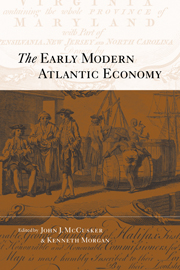Book contents
- Frontmatter
- Contents
- List of figures
- List of tables
- List of abbreviations
- List of contributors
- Dedication
- Introduction
- Part I The role of merchants and their connections
- Part II The development of trades
- Part III Imperial economies
- 9 France, Britain and the economic growth of colonial North America
- 10 Merchants and bankers as patriots or speculators? Foreign commerce and monetary policy in wartime, 1793–1815
- 11 America and the crisis of the British imperial economy,1803–1807
- Part IV Colonial working societies
- Index
11 - America and the crisis of the British imperial economy,1803–1807
from Part III - Imperial economies
Published online by Cambridge University Press: 16 October 2009
- Frontmatter
- Contents
- List of figures
- List of tables
- List of abbreviations
- List of contributors
- Dedication
- Introduction
- Part I The role of merchants and their connections
- Part II The development of trades
- Part III Imperial economies
- 9 France, Britain and the economic growth of colonial North America
- 10 Merchants and bankers as patriots or speculators? Foreign commerce and monetary policy in wartime, 1793–1815
- 11 America and the crisis of the British imperial economy,1803–1807
- Part IV Colonial working societies
- Index
Summary
During the early years of its war against Napoleon, Britain, after a recession in 1803, was on the upswing of a trade cycle, which peaked in 1806, and was not unprosperous. Its domestic exports (mostly manufactured goods) increased in volume by 24 per cent from 1803 to 1806. On the other hand, its re-exports of foreign and colonial merchandise (mainly produce from British colonies) stagnated, as is shown by table 11.1.
Behind these figures loom serious economic difficulties, which, during those years, were affecting the ‘sugar islands’ of the Caribbean, the fisheries of Newfoundland, the colonies of British North America, the East India trade, and also the British merchant fleet, so that one can speak of a crisis of the imperial economy. A common factor behind the troubles of those different sectors was competition from American shipping and trade, which in some cases involved an American penetration into the imperial economy. Those economic developments were to have serious consequences for political relations between Britain and the United States.
The British West Indies had reached their peak of prosperity in the years before the American Revolution. They had suffered greatly during the War of American Independence, as the Royal Navy had lost the control of the seas.
- Type
- Chapter
- Information
- The Early Modern Atlantic Economy , pp. 278 - 316Publisher: Cambridge University PressPrint publication year: 2001



